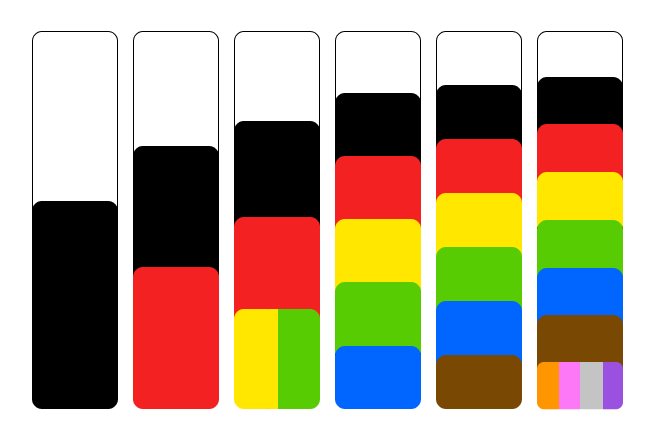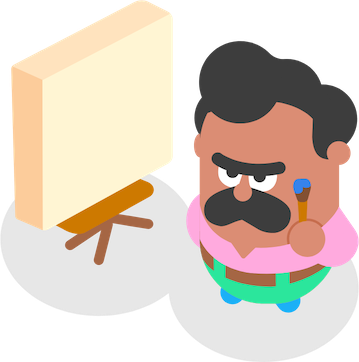English speakers might describe something as “sky blue” or “green like the grass.” But did you know that in some languages the sky is considered the same color as grass?
The way we categorize the millions of colors, shades, and hues depends on our language and our culture. Here are a few of the surprising ways languages describe color!
What is color, anyway?
Colors are different wavelengths of light that our eyes can see: Light with very different wavelengths looks to us like very different colors! Even though there are millions of wavelengths of light, we don’t have a million words to describe them all. (Isn’t language complicated enough already?) Instead, we group colors into categories like “red,” “orange,” and “yellow,” and each of those categories includes light of many (MANY) different wavelengths. We can even describe colors in more detail, with more specific terms, like “crimson,” “tangerine,” and “marigold.”
But what wavelengths belong in which category is sort of arbitrary: There is no universal way of distinguishing where red ends and orange begins. We learn the categories as part of our culture!
Color terms around the world: a hierarchy
We can think of the main categories of colors in a language as basic color words: These are the most basic terms (not the fancy ones like “crimson”), and they represent a whole range of colors. Surprisingly, languages have different numbers of basic color words!
In English, we have 11: black, white, red, green, yellow, blue, brown, orange, pink, purple, and gray. But not all languages have 11, and English didn’t always have 11, either. Some languages have far fewer basic color words—and a few languages have even more.
When comparing basic color terms across languages and cultures, we learn that every language has at least a word for “dark”/“black” and a word for “light”/“white.” If a language has 3 basic terms instead of 2, then the words are for dark/black, light/white, and red. If a language has 4 basic color terms, then the next one is for yellow or green (or a combination of yellow-green wavelengths). In this way, we can make a hierarchy of basic color words. This describes the general pattern in most languages, but you’ll occasionally come across minor exceptions, too!

If you know a language has a word for brown, then it most likely has basic color words for dark/black, light/white, red, yellow, green, and blue, too!
Does your language control the colors you see?
Just because a language has only 2 basic color terms doesn’t mean speakers of the language only see 2 colors: It means the language uses those basic terms to describe other colors. For example, if a language has basic color terms “light” and “dark,” speakers might talk about more specifically reddish colors, by referring to them as a color like blood.
We do this in English, too, even though we have 11 basic color terms. For example, we can use dark in English to encompass “cool” colors like black, blue, and green, while light might correspond to “warm” colors like white, yellow, and red.
Languages with the same number of color terms and similar categories can conceptualize colors differently, too. For example, Chinese and Spanish are pretty similar when it comes to colors, but while one might categorize a certain shade of reddish-orange as “red,” the other language might call it “orange.”
The number of color words can change
Color terms can change over time, with languages and cultures adding more color terms as needed. For example, “pink” is a relatively new basic color term in English, and it was adopted from the name of a flower.
You might notice traces of this in other languages, too! In ancient Japanese, there were four basic color terms: 白 shiro (white), 黒 kuro (black), 赤 aka (red), and 青 ao (a category of blue and green).
Today, there are many more basic color terms in Japanese, after centuries of contact with other languages and cultures: オレンジ orenji (orange), 黄色 kiiro (yellow), and 緑 midori (green).
Traditionally, 青 ao (blue) encompassed what English speakers would consider the categories of green and blue. Today the word has evolved to match the English “blue” category more closely, but there are still cases where the word ao is used for situations that English speakers think of as green: In Japanese, the traffic light turns ao (literally, “blue”) when it’s time to go!

The secret 12th color
There are a few languages that have more basic color terms than English 👀 What we consider 2 different shades of the same color, other languages might consider 2 entirely different categories! Here are 2 examples:
Russian
Russian has 2 words for what English speakers call “blue.” Голубой (goluboy) refers to a light blue and синий (siniy) refers to a dark blue.
Italian
Like Russian, Italian technically has 2 basic color terms for “blue”: blu and azzurro, which refers to a lighter shade of blue.
For other languages, the number of basic color words is debated! Some speakers and linguistics of these next languages say there are only 11 basic terms, and that one of these color words isn’t actually basic (it’s too specific or only used in certain contexts), while other experts say these languages have 12 basic words:
Hungarian
In Hungarian, there might be 2 basic color terms for what English speakers lump together as “red”: piros and vörös, with vörös being a darker red.
Turkish
Turkish might also have 2 different shades of blue, with lacivert being used for dark blue and mavi used for lighter blues.
Languages let their true colors show!
Despite our ability to perceive millions of colors, languages and cultures around the world tend to break down the color spectrum in surprisingly similar ways. So, the next time you look up at the sky or admire the beauty of nature, take a moment to appreciate that deceptively simple question: Yes, why *is* the sky “blue”? 🌈
